 |
|
|
[Sponsors] | |||||
[waves2Foam] Verification against linear waves |
 |
|
|
LinkBack | Thread Tools | Search this Thread | Display Modes |
|
|
|
#1 |
|
Member
Join Date: Dec 2009
Posts: 49
Rep Power: 16  |
Hi Niels,
Thanks for your effort in developing the wave2Foam toolbox. I'm new to OPENFOAM and wave2Foam (start using if two weeks ago). Luckily, I managed to get things up and running. I want to assess the accuracy of wave2Foam for the stokesFirst case. Using really low wave steepness in intermediate water, I tried running the waveFlume tutorial. The phasing matches well with linear potential waves theory but the amplitude got shifted upward making it slightly larger than that of analytical solution. I tried using mesh twice denser but still got the same result. WAVE PARAMETER USED WaveType = stokesFirst Depth, d = 0.4 m Period, T = 2 s Height, H = 0.01 m WaveNumber, k = 1.70048 Omega, w = 3.14159 CORRESPONDING WAVE PROPERTIES Wave amplitude, a = 0.005 m Wave steepness, ak = 0.0085 Dispersion parameter, kd = 0.68 DOMAIN AND MESH PARAMETERS Domain length = 18 m Domain height = 0.6 m Horizontal cell = 360 Vertical cell = 60 Delta x = 0.05 m Delta y = 0.01 m ANALYTICAL SOLUTION FOR LINEAR WATER WAVES (FREE SURFACE) ZetaAnalytical = a * cos ( k*x - omega*t ) RESULTS Phasing error ~ 0 % Amplitude error ~ 4 % Is there anything that I should tweak in order to get more accurate result? Does viscosity and density between the water and air affect the result? 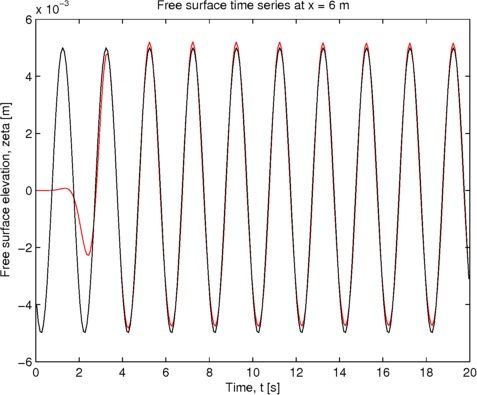 Kind regards, katakgoreng |
|
|
|

|
|
|
|
|
#2 |
|
Senior Member
Niels Gjoel Jacobsen
Join Date: Mar 2009
Location: Copenhagen, Denmark
Posts: 1,900
Rep Power: 37   |
Hello Katakgoreng,
Have you tried comparing your solution with second order Stokes? From my quick look into second order Stokes, then the second order amplitude is 2.7% of the first order amplitude for your conditions, so 4% off is not that bad  Kind regards, Niels
__________________
Please note that I do not use the Friend-feature, so do not be offended, if I do not accept a request. |
|
|
|

|
|
|
|
|
#3 | |
|
Member
Join Date: Dec 2009
Posts: 49
Rep Power: 16  |
Quote:
Thank you for your suggestion. Comparison with second order Stokes yield much better result. With maximum amplitude error of 1.4 %.  Will try another case. 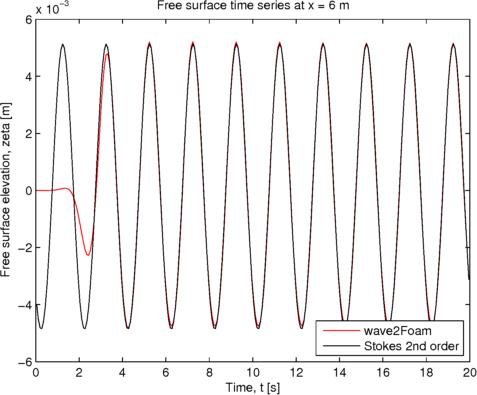 Kind regards, katakgoreng Last edited by katakgoreng; August 28, 2013 at 13:41. Reason: legend for figure |
||
|
|

|
||
|
|
|
#4 |
|
Senior Member
Niels Gjoel Jacobsen
Join Date: Mar 2009
Location: Copenhagen, Denmark
Posts: 1,900
Rep Power: 37   |
Considering the fact that you only have 1 cell over the wave height, the result is really, really good!
Kind regards, Niels
__________________
Please note that I do not use the Friend-feature, so do not be offended, if I do not accept a request. |
|
|
|

|
|
|
|
|
#5 |
|
Member
Join Date: Dec 2009
Posts: 49
Rep Power: 16  |
Hi Niels,
(# UPDATE : I MADE MISTAKES IN THIS SIMULATION. I INCREASE THE WATER DEPTH IN THE "waveProperties" FILE BUT I DON'T CHANGE THE SIZE OF THE DOMAIN. THANKS NIELS FOR POINTING THINGS OUT..) After the success of running intermediate water waves, I tried running wave2Foam for deep water waves. It seems like for deep water, the dispersion is not properly resolved resulting in slower wave propagation (compared to Stokes 2nd Order). Furthermore, the maximum amplitude is damped a bit after propagate from the inlet and stays constant until the end. Below are the wave parameters that I used: DOMAIN AND MESH PARAMETERS FOR BOTH CASES Domain length = 18 m Domain height = 0.6 m Horizontal cell = 360 Vertical cell = 60 Delta x = 0.05 m Delta y = 0.01 m INTERMEDIATE WATER WAVE PROPERTIES Water depth, d : 0.4 Wave period, T : 2 Wave height, H : 0.01 Wave number, k : 1.7005 Wave amplitude, a : 0.005 Wave frequency, omega : 3.1416 Wave steepness, ak : 0.0085024 Dispersion, kd : 0.68019 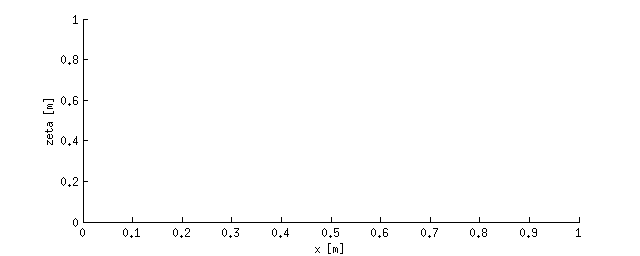 DEEP WATER WAVE PROPERTIES Water depth, d : 3.1416 Wave period, T : 2 Wave height, H : 0.01 Wave number, k : 1.0096 Wave amplitude, a : 0.005 Wave frequency, omega : 3.1416 Wave steepness, ak : 0.0050481 Dispersion, kd : 3.1718  Note : Dash line (wave2Foam), solid line (Stokes 2nd Order) Have you run parametric study on the range of validity of wave2Foam in terms of wave steepness as well as degree of dispersion? Kind regards, katakgoreng Last edited by katakgoreng; August 30, 2013 at 11:08. Reason: figure labeling, mesh information |
|
|
|

|
|
|
|
|
#6 |
|
Senior Member
Niels Gjoel Jacobsen
Join Date: Mar 2009
Location: Copenhagen, Denmark
Posts: 1,900
Rep Power: 37   |
Hi,
It really looks strange. Good you upload the deep water case here, and I will try to have a look at it tonight. The only thing, which I can think of: You have also increased the size of the computational domain, correct? Because it looks like the wave have the similar attributes as for the intermediate water depth. If not, then the model merely make the wave fit the water depth in the computational domain. Kind regards Niels
__________________
Please note that I do not use the Friend-feature, so do not be offended, if I do not accept a request. |
|
|
|

|
|
|
|
|
#7 | |
|
Member
Join Date: Dec 2009
Posts: 49
Rep Power: 16  |
Quote:
I use the the same domain and mesh properties for both cases. For the deep water case, I: 1. Change the water depth for the deep water case in "waveProperties.input" 2. Run "setWaveParameters" and obtain the wave properties. 3. Run wave2Foam ("./Allrun") 4. Verify with 2nd order Stokes The wave number, k for both cases are different. However, when I do the verification, the analytical 2nd order Stokes uses values from each individual cases. I have write a matlab code that 1. Extract the wave properties from "waveProperties" file 2. Extract free surface elevation from "surfaceElevation.dat" 3. Compare with 2nd Order Stokes 4. Produce gif animation The code is attached with this post. * If anyone interested to use the code, just copy the "Matlab" folder into "waveFlume" folder. Kind regards, katakgoreng Last edited by katakgoreng; August 30, 2013 at 10:14. Reason: word mistakes |
||
|
|

|
||
|
|
|
#8 |
|
Senior Member
Niels Gjoel Jacobsen
Join Date: Mar 2009
Location: Copenhagen, Denmark
Posts: 1,900
Rep Power: 37   |
The problem then is that the actual water depth is still 0.4 m, because the bottom is placed at this level. Therefore, the interior part of the computational domain will act accordingly, and that is why your comparison is as bad as it is.
Create a new mesh with the correct water depth, and I can assure you that the results will be substantially better. Kind regards Niels
__________________
Please note that I do not use the Friend-feature, so do not be offended, if I do not accept a request. |
|
|
|

|
|
|
|
|
#9 | |
|
Member
Join Date: Dec 2009
Posts: 49
Rep Power: 16  |
Quote:
Owh. My bad.  I totally missed that one. I should change the domain of the problem to reflect the increase in the water depth. That's why the simulation gave weird result. I totally missed that one. I should change the domain of the problem to reflect the increase in the water depth. That's why the simulation gave weird result. So : 1. Increase water depth, d 2. Change the domain to reflect the increase in water depth (this is extremely important) 3. Change the vertical mesh resolution 4. Run wave2Foam I will report back as soon as I get the result. Thanks Niels. Kind regards, katakgoreng ( # UPDATE ) Managed to get the deep water wave propagation right this time. Phase and amplitude shows good agreement with Stokes 2nd order. Although it seems that I should make the domain much longer to avoid wave reflection from polluting the solution.  Note : Dashed line (wave2Foam), solid line (Stokes 2nd order) Last edited by katakgoreng; August 30, 2013 at 12:50. Reason: word mistakes, add verification figure |
||
|
|

|
||
|
|
|
#10 |
|
Senior Member
Niels Gjoel Jacobsen
Join Date: Mar 2009
Location: Copenhagen, Denmark
Posts: 1,900
Rep Power: 37   |
Thank you very much, Katakgoreng, for the disclaimer in your edited post.
Have a nice weekend. Niels
__________________
Please note that I do not use the Friend-feature, so do not be offended, if I do not accept a request. |
|
|
|

|
|
|
|
|
#11 |
|
Member
Join Date: Dec 2009
Posts: 49
Rep Power: 16  |
Hi Niels,
I have tested wave2foam for regular waves and so far the results is quite accurate (provided that I have enough mesh in the viscinity of the free surface). I'm interested to try the irregular waves function (JONSWAP). I have specify the JONSWAP spectrum in "waveProperties.input" as follows: waveType : irregular; spectrum : JONSWAP; N : 151; Tsoft : 3; writeSpectrum : false; Hs : 0.046; Tp : 1.2; gamma : 2.5; depth : 0.7; direction : ( 1 0 0 ); There is no information for the focusing time and location so I assume that the focused wave occur at xf = 0 and tf = 0, where (xf is the focusing location and tf is the focusing time). Is there any way that I could change the focusing location and time to a specified values? Kind regards, katakgoreng |
|
|
|

|
|
|
|
|
#12 |
|
Senior Member
Niels Gjoel Jacobsen
Join Date: Mar 2009
Location: Copenhagen, Denmark
Posts: 1,900
Rep Power: 37   |
Good evening Katakgoreng,
I am glad to hear that you are so far happy with the results. The irregular wave is exactly an irregular wave train, so the phasing is set to a random value, i.e. there is not any focusing time/location as an option. To achieve this, it will require some implementation. Kind regards, Niels
__________________
Please note that I do not use the Friend-feature, so do not be offended, if I do not accept a request. |
|
|
|

|
|
|
|
|
#13 | |
|
Member
Join Date: Dec 2009
Posts: 49
Rep Power: 16  |
Quote:
Thank you for your clarification. I noticed when I run "setWaveParameters", in "waveProperties", sets of values (from the JONSWAP spectrum) are generated: (a) amplitude (b) frequency (c) phaselag (d) waveNumber amplitude, frequency and wavenumber are typical values corresponding to the JONSWAP spectrum. Would you mind clarifying what "phaselag" is? Is this what you mean by random phasing? Is "phaselag" equal to "phi" as in regular wave theory? Kind regards, katakgoreng |
||
|
|

|
||
|
|
|
#14 |
|
Senior Member
Niels Gjoel Jacobsen
Join Date: Mar 2009
Location: Copenhagen, Denmark
Posts: 1,900
Rep Power: 37   |
Yes, phaselag is the same as phi in the regular wave theories. Sorry for the inconsistency in naming. Also, phaselag is the random variable.
Kind regards, Niels
__________________
Please note that I do not use the Friend-feature, so do not be offended, if I do not accept a request. |
|
|
|

|
|
|
|
|
#15 | |
|
Member
Join Date: Dec 2009
Posts: 49
Rep Power: 16  |
Quote:
So I guess, I could calculate the phaselag for every waves so that they coincide at the focusing time and location that I want. Will try it. Thanks Niels.  Kind regards, katakgoreng # UPDATE I managed to get the waves to focused based on focusing time and location that I prescribed. I do this by calculating the phase-lag of each individual waves so that they coincide at the prescribed values. So the formula that I used for calculating phase-lag is as follows: phi = k * xf - omega * tf where phi = individual phase-lag k = individual waves number omega = individual waves angular frequency given by 2*pi*f f = individual waves frequency xf = focusing location tf = focusing time I replace the calculated phase-lag from "setWaveParameter" with the new phase-lag. The result shows excellent agreement with linear random wave theory. BTW, this is TopHat spectrum (same amplitude for each individual waves, again I replace the value generated from "setWaveParameter") The focusing location, xf = 8 m from inlet whilst focusing time, tf = 32 s. Maximum amplitude error is 1.5%. The trough before and after the focused event is slightly under-predicted whilst the focused location drifted just abit due to either non-linear effect or inadequate mesh resolution in the vertical and horizontal direction. 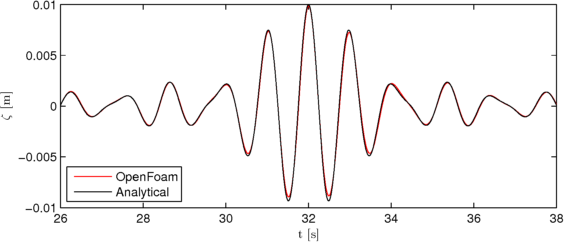 The legend supposed to be "waves2Foam"..sorry about that.. # UPDATE 2 Focused waves for JONSWAP spectrum at xf = 8m and tf = 32s. The mesh used is the same as in TopHat spectrum. It is pretty evidence that the mesh is under-resolved as the short waves riding on longer waves is not being resolved properly, resulting in decreasing in maximum focused amplitude. Using denser mesh could result in much better result. 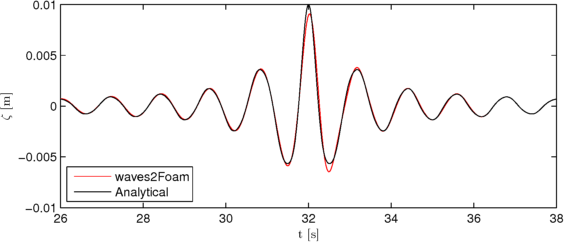
Last edited by katakgoreng; September 11, 2013 at 11:33. Reason: Result update |
||
|
|

|
||
|
|
|
#16 |
|
Senior Member
Niels Gjoel Jacobsen
Join Date: Mar 2009
Location: Copenhagen, Denmark
Posts: 1,900
Rep Power: 37   |
Hi Katakgoreng,
Thanks for the updates. I would say that the results do look pretty nice, and I am happy to see the predictive capabilities validated. Just out of curiosity, have you constructed the wave components inside or outside setWaveParameters? If still outside, then I do have some ideas on how to make it all work with as little work as possible. Essentially, if you post the code, which you use for creating the phases, i.e. required information from the user and the exact computation of the phases, then I could probably put it into waves2Foam during this weekend. Please, also add the waveProperties- and waveProperties.input-files for JONSWAP, such that I can compare the created files. Kind regards Niels EDIT: Sorry, after carefully reading your post from above, I can see that the equations are already there. I will make sure that it get integrated in the setWaveProperties.
__________________
Please note that I do not use the Friend-feature, so do not be offended, if I do not accept a request. Last edited by ngj; September 14, 2013 at 19:25. |
|
|
|

|
|
|
|
|
#17 |
|
Senior Member
Niels Gjoel Jacobsen
Join Date: Mar 2009
Location: Copenhagen, Denmark
Posts: 1,900
Rep Power: 37   |
Good morning,
This morning I have added the option of focusing an incident irregular wave train in a given time and a given location as inspired by Katakgoreng. For the control, please see http://openfoamwiki.net/index.php/Co...ar_wave_theory If you are using standard random phasing of the incident irregular waves, then you do not have to do anything, but a slight increase in control is added through a manual choice of seeding for the random number generator. Kind regards Niels
__________________
Please note that I do not use the Friend-feature, so do not be offended, if I do not accept a request. |
|
|
|

|
|
|
|
|
#18 |
|
Member
Join Date: Dec 2009
Posts: 49
Rep Power: 16  |
Hi Niels,
Sorry for not replying your previous post abit earlier. I haven't been online on the weekend. The latest addition is pretty neat. No need to calculate the phaselag outside "setWaveParameters". I have updated svn and recompile wave2Foam. I have the following in "waveProperties.input" phaseMethod focusingPhase; focusTime 32; focusPoint (8 0 0); I have the following bug (not quite sure if its on my computer only) : Bug 1: When I run "setWaveParameters", I got keyword equidistantFrequencyAxis is undefined in dictionary ... I then add "equidistantFrequencyAxis" into the "waveProperties.input" and set the value to 1. The error then goes away. Is this new additional control that you add for irregular wave theory as I can't seem to find it ever mentioned in http://openfoamwiki.net/index.php/Co...ar_wave_theory Bug 2: I have the following in "waveProperties.input". outletCoeffs { waveType potentialCurrent; U ( 0 0 0 ); Tsoft 2; relaxationZone { relaxationScheme Spatial; relaxationShape Rectangular; beachType Empty; relaxType OUTLET; startX (15 0.0 -1); endX (20 0.0 1); orientation (1.0 0.0 0.0); } } When I run "setWaveParameters", the "outletCoeffs" is not written in "waveProperties" file. Do you experience similar problem or is it just on my system? Kind regards, katakgoreng # UPDATE : Thanks Niels for pointing things out. Bug 1 : Not a bug, additional control added by Niels. Bug 2 : Not a bug, using file provided by Niels, the code run just fine. It could be that I made some typo error in the input file. Last edited by katakgoreng; September 17, 2013 at 05:58. |
|
|
|

|
|
|
|
|
#19 |
|
Senior Member
Niels Gjoel Jacobsen
Join Date: Mar 2009
Location: Copenhagen, Denmark
Posts: 1,900
Rep Power: 37   |
Hi,
With respect to "bug 1", then it is not a bug, but a new feature for increased control of the irregular wave spectrum. I have also added the option of user-defined frequency cut-offs. The description has now been updated on the wiki. With respect to "bug 2", then I do not experience those type of problems. I made a quick test on the attached waveProperties.input file. This test, however, made me realise that not all the new information on phasing, etc, is carried along in the writing process. This does not have any consequence for the results, as they are purely pre-processing parameters, but they would be nice to have for future reference. This will be added in a future revision. Kind regards, Niels P.S. I was not allowed to upload files called *.input, so merely rename.
__________________
Please note that I do not use the Friend-feature, so do not be offended, if I do not accept a request. |
|
|
|

|
|
|
|
|
#20 | |
|
Member
Join Date: Dec 2009
Posts: 49
Rep Power: 16  |
Quote:
Thanks. Both are not bugs. Using the file that you provided, I managed to get the waveProperties just fine. Currently, I'm running quite an extensive simulation. I'm interested in the post-processing result given by waves2Foam such as the free surface elevation. If I stop the simulation, how can I continue from the latestTime and concatenated the result into "surfaceElevation.dat" file? Kind regards, katakgoreng |
||
|
|

|
||
 |
|
|
 Similar Threads
Similar Threads
|
||||
| Thread | Thread Starter | Forum | Replies | Last Post |
| 2nd Order Convergence Problem for 3D Airfoil | turkmengokce | OpenFOAM Running, Solving & CFD | 1 | September 10, 2015 07:20 |
| A turbulent test case for rhoCentralFoam | immortality | OpenFOAM Running, Solving & CFD | 13 | April 20, 2014 06:32 |
| suitable boundary condition for scavenging process? | immortality | OpenFOAM Running, Solving & CFD | 3 | January 25, 2013 19:10 |
| how to modify fvScheme to converge? | immortality | OpenFOAM Running, Solving & CFD | 15 | January 16, 2013 13:06 |
| solution diverges when linear upwind interpolation scheme is used | subash | OpenFOAM | 0 | May 29, 2010 01:23 |